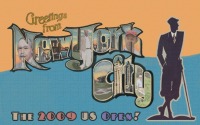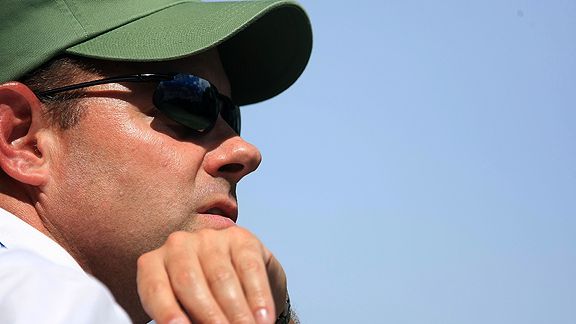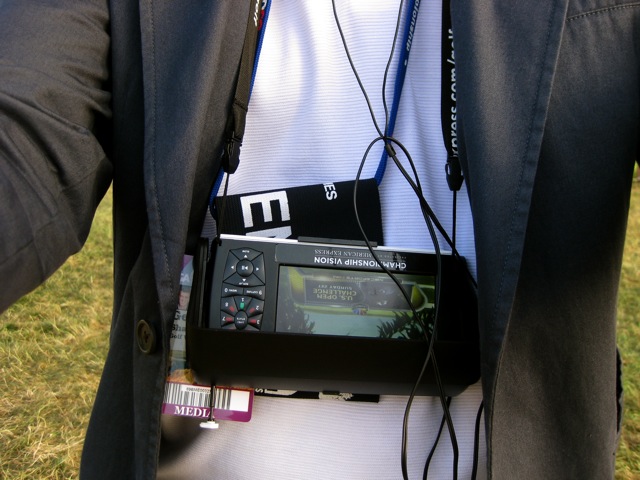Some of the names that caught my eye for today's play courtesy of the USGA's release. I'll try to get some scoring links up courtesy of readers who think they can beat USGA.org.
STORYLINES FROM 2009 U.S. OPEN SECTIONAL QUALIFYING
Saticoy Country Club (Somis, Calif.)
· Tim Hogarth of Northridge, Calif., won the 1996 U.S. Amateur Public Links and was a 1999 USGA Men’s State Team participant.
· Jamie Lovemark of Rancho Santa Fe, Calif., played on the winning 2007 USA Walker Cup team. He was the individual champion at the 2007 NCAA Division I Championship as a member of the University of Southern California golf team.
· Duffy Waldorf of Northridge, Calif., is a four-time PGA Tour winner who has played in 13 U.S. Opens, tying for ninth in 1994, and was a member of the victorious 1985 USA Walker Cup team.
Lake Nona Golf and Country Club (Orlando, Fla.)
· John Cook of Orlando, Fla., was the 1978 U.S. Amateur champion and 1979 U.S. Amateur runner-up. He is an 11-time winner on the PGA Tour and has played in 23 U.S. Opens. His best finish came in 1981 (4th). A member of the Champions Tour, he also finished fifth in the 2008 U.S. Senior Open.
Hawks Ridge Golf Club (Ball Ground, Ga.)
· Matthew Kuchar of Atlanta, Ga., is a former standout at Georgia Tech and a PGA Tour member who won the 1997 U.S. Amateur. A member of the 1999 USA Walker Cup team, Kuchar has played in six U.S. Opens, earning low-amateur honors in 1998 with a 14th-place finish. He tied for 48th last year.
· Grayson Murray, 15, of Raleigh, N.C., is the youngest player in all of the sectional qualifying fields (DOB: Oct. 1, 1993).
Woodmont Country Club (Rockville, Md.)
· Fred Funk of Ponte Vedra Beach, Fla., is a member of the PGA and Champions Tours who has played in 19 U.S. Opens, finishing sixth in 2004. He was runner-up at the 2008 U.S. Senior Open.
· Neal Lancaster of Smithfield, N.C., who tied for fourth at the 1995 U.S. Open, plays on the PGA and Nationwide Tours. He has played in three U.S. Opens and shares a U.S. Open record with Vijay Singh, shooting 29 for nine holes (second nine, fourth round in 1995 and second nine, second round in 1996).
Old Oaks Country Club / Century Country Club (Purchase, N.Y.)
· Michael Allen of Scottsdale, Ariz., recently won the 2009 Senior PGA Championship in his first start as a 50-and-over player. He has played in five U.S. Opens, tying for 12th in 2001. He also is a former assistant pro at Winged Foot.
· Brad Faxon of Barrington, R.I., is a member of the PGA Tour who has played in 20 U.S. Opens. His best finishes came in 1989 and 1994, when he tied for 33rd. He played on the victorious 1983 USA Walker Cup team.
· Andrew Giuliani of New York, N.Y., is the son of former New York City mayor Rudy Giuliani. A former member of the Duke University golf team, he earned the final qualifying spot at Brooklawn Country Club in Fairfield, Conn.
· Andrew Svoboda of Larchmont, N.Y., finished 71st at last year’s U.S. Open after getting into the field as an alternate. He was a semifinalist at the 2004 U.S. Amateur and also played in the 2006 U.S. Open. Both of those events were at Winged Foot, where his parents are members and where he has won the club championship.
· French-born Jean Van de Velde of Dubai has played in two U.S. Opens, including a 45th-place finish in 2002 at Bethpage. He is best known for his runner-up finish at the 1999 British Open, losing in a three-man playoff to Paul Lawrie.
· Cameron Wilson, 16, of Rowayton, Conn., advanced to match play at the U.S. Junior Amateur in 2007 and 2008, and is the second-youngest golfer in sectional qualifying. He is one of three players under 17 to qualify for sectionals.
Brookside Golf and Country Club / The Lakes Golf and Country Club (Columbus, Ohio)
· Aaron Baddeley of Scottsdale, Ariz., is a PGA Tour member who was runner-up at the 1998 U.S. Junior Amateur, where he was the stroke-play medalist. He has played in four U.S. Opens, tying for 13th in 2007 and 29th in 2008.
· Chris DiMarco of Orlando, Fla., is a PGA Tour member who has played in eight U.S. Opens. He tied for ninth in 2004 – his best U.S. Open finish – and 24th in 2002 at Bethpage.
· David Duval of Denver, Colo., is a PGA Tour member who has played in 14 U.S. Opens, tying for seventh in 1998 and 1999. He won the 1989 U.S. Junior Amateur and was a member of the winning 1991 USA Walker Cup team.
· Steve Flesch of Union, Ky., is a PGA Tour member who has played in 10 U.S. Opens. He tied for 18th in 2002 at Bethpage and tied for seventh in 2004.
· J.B. Holmes of Campbellsville, Ky., is a member of the PGA Tour who has played in three U.S. Opens, tying for 48th in 2006. He was a USA Walker Cup team member in 2005 and played on the 2008 USA Ryder Cup team.
· Danny Lee of New Zealand won the 2008 U.S. Amateur. As an amateur, he won the 2009 Johnnie Walker Classic, a European Tour event. He has since turned professional and thus gave up his full exemption into the 2009 U.S. Open.
· Tom Lehman of Scottsdale, Ariz., is a member of the PGA and Champions Tour who has played in 16 U.S. Opens. He had four consecutive top-five finishes at the U.S. Open from 1995-98. He also won the 1996 British Open.
· Jack Newman of Des Moines, Iowa, is a member of the Michigan State University golf team who won the 2008 U.S. Amateur Public Links. As a result, he played in the 2009 Masters but failed to make the cut.
· Jose Maria Olazabal of Spain is a PGA Tour member who has played in 17 U.S. Opens and was recently chosen for induction into the World Golf Hall of Fame. A two-time Masters champion, he tied for eighth at the 1990 and 1991 U.S. Opens.
Germantown Country Club / Ridgeway Country Club (Memphis, Tenn.)
· Alex Cejka of Germany is a PGA Tour member who has played in three U.S. Opens, making the cut each time. He tied for 50th at the 1996 U.S. Open.
· John Daly of Dardanelle, Ark., currently plays on the European Tour but will be making his first PGA Tour appearance of the season at the St. Jude Championship, which begins June 11. He has played in 13 U.S. Opens, including in 2002 at Bethpage. His best finish came in 1996 when he tied for 27th. He won the 1991 PGA Championship as an alternate and claimed the British Open four years later.
· James Driscoll of Brookline, Mass., is a PGA Tour member who was runner-up at the 1995 U.S. Junior Amateur and the 2000 U.S. Amateur. He was a member of the 2001 USA Walker Cup team.
· Steve Elkington of Australia is a 10-time winner on the PGA Tour who has played in 12 U.S. Opens. He tied for 21st in 1989 and 1990. He also won the 1995 PGA Championship.
· Brian Gay of Windermere, Fla., is a PGA Tour member who has played in five U.S. Opens. He was a member of the victorious 1993 USA Walker Cup team.
· Jason Gore of Valencia, Calif., is a PGA Tour member who has played in three U.S. Opens. He tied for 49th at the 2005 U.S. Open, where he played in Sunday’s final pairing with Retief Goosen, and was a member of the winning 1997 USA Walker Cup team.
· Paul Goydos of Coto de Caza, Calif., is a PGA Tour member who has played in nine U.S. Opens, tying for 12th in 1999. He failed to make the cut in 2002 at Bethpage.
· Tom Shaw of Franklin, Tenn., is the head golf coach at Vanderbilt University. A previous member of the PGA and Champions Tours, he has played in nine U.S. Opens and 12 U.S. Senior Opens.
· Scott Verplank of Edmond, Okla., is a five-time winner on the PGA Tour who has played in 17 U.S. Opens, including the past 11. He won the 1984 U.S. Amateur and was a member of the victorious 1985 USA Walker Cup team.
Northwood Club (Dallas, Texas)
· Olin Browne of Tequesta, Fla., is a PGA Tour member who has played in 11 U.S. Opens. He tied for fifth in 1997.
· Bronson Burgoon of Dallas, Texas, recently helped Texas A&M capture the team title at the 2009 NCAA Division I Championship. His victory in match play sealed the Aggies’ win over the University of Arkansas.
 Via GolfDigest.com, my Twitter page and this page, I'll be covering the Open in a variety of ways.
Via GolfDigest.com, my Twitter page and this page, I'll be covering the Open in a variety of ways.



















